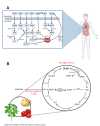NAD+ Precursors Nicotinamide Mononucleotide (NMN) and Nicotinamide Riboside (NR): Potential Dietary Contribution to Health
- PMID: 37273100
- PMCID: PMC10240123
- DOI: 10.1007/s13668-023-00475-y
NAD+ Precursors Nicotinamide Mononucleotide (NMN) and Nicotinamide Riboside (NR): Potential Dietary Contribution to Health
Abstract
Purpose of review: NAD+ is a vital molecule that takes part as a redox cofactor in several metabolic reactions besides being used as a substrate in important cellular signaling in regulation pathways for energetic, genotoxic, and infectious stress. In stress conditions, NAD+ biosynthesis and levels decrease as well as the activity of consuming enzymes rises. Dietary precursors can promote NAD+ biosynthesis and increase intracellular levels, being a potential strategy for reversing physiological decline and preventing diseases. In this review, we will show the biochemistry and metabolism of NAD+ precursors NR (nicotinamide riboside) and NMN (nicotinamide mononucleotide), the latest findings on their beneficial physiological effects, their interplay with gut microbiota, and the future perspectives for research in nutrition and food science fields.
Recent findings: NMN and NR demonstrated protect against diabetes, Alzheimer disease, endothelial dysfunction, and inflammation. They also reverse gut dysbiosis and promote beneficial effects at intestinal and extraintestinal levels. NR and NMN have been found in vegetables, meat, and milk, and microorganisms in fermented beverages can also produce them. NMN and NR can be obtained through the diet either in their free form or as metabolites derivate from the digestion of NAD+. The prospection of NR and NMN to find potential food sources and their dietary contribution in increasing NAD+ levels are still an unexplored field of research. Moreover, it could enable the development of new functional foods and processing strategies to maintain and enhance their physiological benefits, besides the studies of new raw materials for extraction and biotechnological development.
Keywords: NAD+ precursors; Nicotinamide mononucleotide; Nicotinamide riboside; Promoting health; Pyridine derivatives.
© 2023. The Author(s), under exclusive licence to Springer Science+Business Media, LLC, part of Springer Nature.
Conflict of interest statement
The authors do not have any potential conflicts of interest to disclose.
Figures


References
-
- Yamaguchi S, Franczyk MP, Chondronikola M, Qi N, Gunawardana SC, Stromsdorfer KL, et al. Adipose tissue NAD+ biosynthesis is required for regulating adaptive thermogenesis and whole-body energy homeostasis in mice. Proc Natl Acad Sci. 2019;116(47):23822–23828. doi: 10.1073/pnas.1909917116. - DOI - PMC - PubMed
-
- Abdellatif M, Sedej S, Kroemer G. NAD+ Metabolism in cardiac health, aging, and disease. circulation. 2021;144(22):1795–817. - PubMed
Publication types
MeSH terms
Substances
LinkOut - more resources
Full Text Sources
Research Materials
